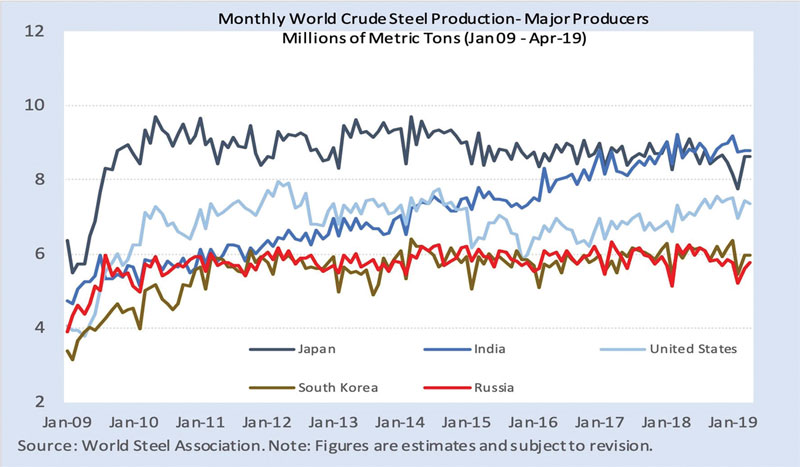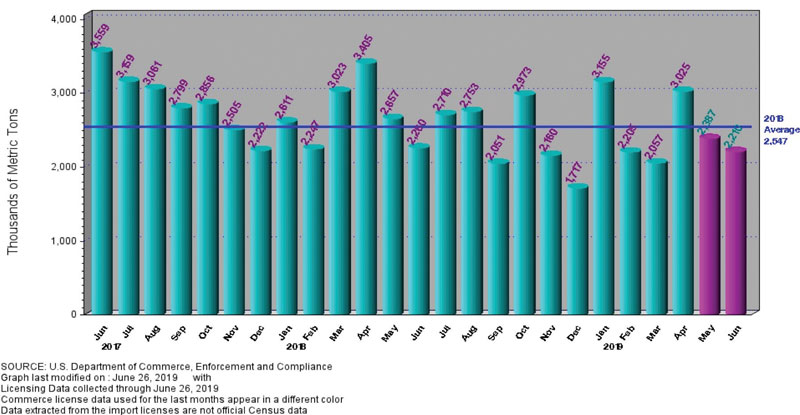Producers are shifting capacity from China to Southeast Asia and logistics companies are responding with increasing investments but U.S. authorities are looking out for tariff cheats.
On July 2, the U.S. Department of Commerce slapped preliminary duties as high as 456.23 percent on some steel imports from Vietnam. The rationale: circumvention of antidumping and countervailing tariffs against corrosion-resistant (CORE) and cold-rolled steel (CRS) from South Korea and Taiwan.
Commerce found that certain steel products that were first produced in South Korea and Taiwan were then shipped to Vietnam for minor processing before being exported to the United States. Spikes in shipments of CORE and CRS from Vietnam to the U.S. provided the department with a big clue. CORE shipments increased 4,076% from December 2015 to April 2019, while CRS increased 922% from February 2016 to April 2019.

This isn’t the first-time penalties were imposed on imports from Vietnam. In December 2017, DOC hit CORE and CRS imports with punitive tariffs, claiming they originated in China. In March 2019, U.S. Customs found some importers were evading duties for imported aluminum door thresholds from China that were transshipped through Vietnam with false declarations of origin and without depositing antidumping or countervailing duties. These kinds of investigations are on the rise, according to a recent report from the international law firm Baker & McKenzie, which noted that deliberate falsification of import documents can lead to criminal liability.
Manufacturing Shift
There are several developments at play with these kinds of stories. Producers have been shifting manufacturing capacity from China to Vietnam and other countries for years but the tariff situation has accelerated that trend and it’s become clear that Vietnam is benefiting from the U.S.-China trade war. Vietnam “has been called ‘the new China,’” noted a recent report from the Council on Foreign Relations, “given its low wages and lax labor and environmental regulations.” U.S. imports from Vietnam increased 34% in the first five months of 2019.
The spike in exports from Vietnam to the U.S. has earned the country President Donald Trump’s ire, who described Vietnam as “almost the single-worst abuser of everybody.” Vietnam’s trade surplus with the U.S. has increased from $20 billion in 2014 to $39.5 billion last year. The problem unmasked by the most recent tariff case is that increases in imports from Vietnam represent not only efforts at tariff avoidance but tariff evasion.
Vietnamese officials say they are working on reducing the trade surplus with the U.S., according to published reports, and are cracking down on Chinese manufacturers who are rerouting their goods through their country. The U.S. Embassy in Hanoi announced that it has conducted talks with Vietnamese authorities and that it hopes Vietnam will take steps to address U.S. concerns.
“The tariffs will hurt Vietnam,” opined Chang Shu, chief Asia economist at Bloomberg, speaking of the latest round, on steel, “among the few countries that have benefited from trade tensions between the U.S. and China.”

Cost Versus Quality
U.S. importers have endeavored to diversify their source of supply to lower-cost countries like Vietnam even before the tariff wars started, citing rising costs in China. But many have found that it’s hard to duplicate the quality and scale of manufacturing capacity that the People’s Republic has to offer. Logistics also presents a problem, as there are fewer transportation options, leading to longer transit times and less flexibility for supply chains, but there are signs of improvement on that front.
According to John Singleton, CEO of Wen Parker Logistics, 20% to 25% of production capacity currently located in China will eventually shift elsewhere over a period of years. “Companies still deep in China are those with price points that can withstand tariffs and higher costs and that can’t find the desired quality elsewhere yet,” he said.
Chasing low labor rates may be a fool’s errand in the long run, as labor rates will presumably rise everywhere as the global economy develops. But Vietnam is still one of those places “where lots of people are still scrambling for entry-level work,” according to Singleton.
Logistics infrastructures will have to be improved if Vietnam is to further develop its manufacturing prowess and there are signs that logistics companies are beginning to make those investments. At this point, many shipments originating in Vietnam are consolidated in Shanghai, Hong Kong, and Singapore, leading to transit times from Vietnam as much as double those from China.

Vietnam is seeing rising incomes and improving infrastructures, according to John Carr, president and CEO of MIQ Logistics. “This is one of the reasons why we are building up our presence in Vietnam,” he said.
New Services to Match Sourcing
The planning processes required for sourcing changes mean that companies cannot shift their sourcing patterns on a dime, nor can ocean carriers revamp their operations quickly. Some of the ship lines have tweaked their service offerings and port calls to better accommodate increased volumes out of Southeast Asia, according to Sri Laxmana, vice president for global ocean services at CH Robinson.
“If the tariff war continues to escalate,” he said, “you may see more direct services out of Southeast Asia.”
According to a recent report from Agility Logistics, India and China remain the leading investment destinations for the logistics industry. But Vietnam leads a second group that is drawing increased interest from the industry, thanks to its diversity of exports.
“Vietnam will offer potential big growth for exporters in the coming years,” said Steven Gundlach, a DB Schenker executive vice president. “Vietnam’s booming business extending from manufacturing to the exporting of mobile phones and furniture shows no signs of slowing. The country has a good diversification of products to export and continues to increase its exports into the U.S. market.”
The shift into Vietnam of manufacturing from China has been part of a continued, normal migration of industry to lower-cost venues, while the accelerated pace of investment has been brought on by the Trump tariffs that have been directed at China. Vietnam may continue to benefit from the U.S.-China trade war, but exporters and importers should bear in mind that the Department of Commerce and U.S. Customs are on the lookout for cases of tariff evasion.

Follow us on social media: